|
Just as a city is home to different communities of people, the Big Thicket is home to different communities of plants. Soil type and elevation are the primary factors for the region's biodiversity. Each plant community, or ecosystem, is defined by certain dominant species of trees and/or shrubs. Those dominant species can help you identify different plant communities as you explore the preserve. Upland Plant Communities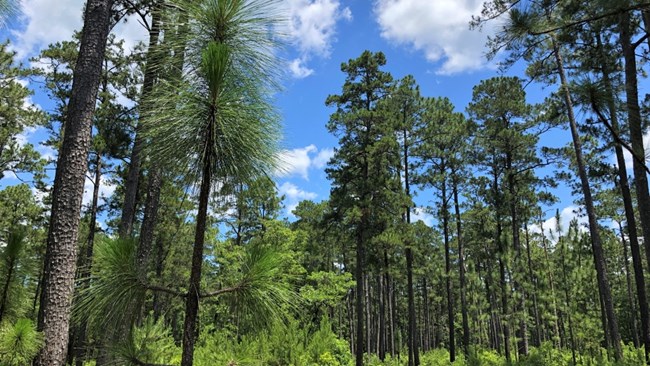
NPS Photo / Scott Sharaga Longleaf Pine UplandWell-drained uplands and ridges are home to longleaf pine upland forests mixed with shortleaf pine, loblolly pine, blackjack oak, bluejack oak, and post oak. Grasses and forbs (including Texas trailing phlox) form an herbaceous understory in this fire-dependent community when fires occur at frequent intervals. The northwest part of the Big Sandy Creek Unit protects this plant community. 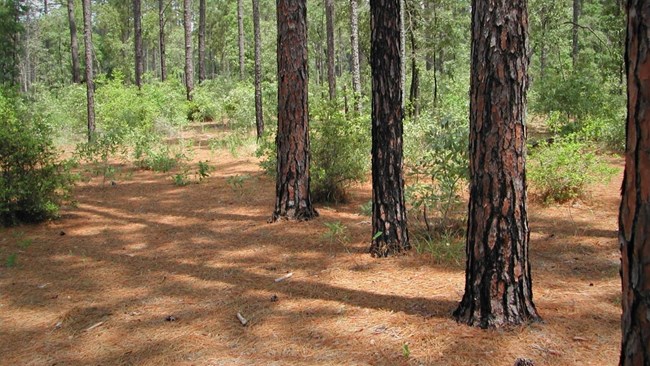
NPS Photo Arid SandylandArid sandylands are rare, occurring where ancient seas, rivers, and flood events deposited enough sand to form dunes and sandhills. They are characterized by scattered shrub patches and an overstory of longleaf pine; sand, bluejack, and post oaks; and scattered shortleaf, and loblolly pines. Because of low soil moisture, this community also supports a number of species adapted to dry conditions, including prickly pear cactus and yucca. The Sandhill Loop Trail and the nearby Roy E. Larsen Sandyland Sanctuary are the best places to explore this plant community. 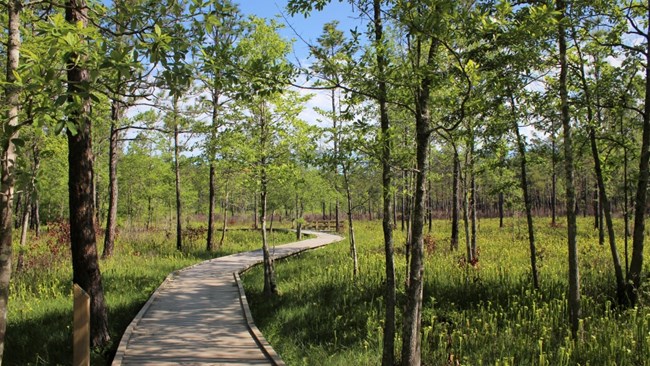
NPS Photo / Scott Sharaga Wetland Pine SavannahWetland pine savannahs contain the richest botanical diversity in the preserve, with up to 100 species of forbs and grasses per acre. These communities occur on poorly drained soils where water pools seasonally, which inhibits tree growth. Scattered longleaf pines form the overstory, while shrubs include sweetbay magnolia, gallberry holly, wax myrtle, and titi (pronounced ‘tie-tie’). Orchids and insectivorous plants can be found in the herbaceous layer, along with sedges when soil moisture and light conditions are just right. The Sundew Trail and Pitcher Plant Trail are the best places to experience this plant community. Slope Forest Plant Communities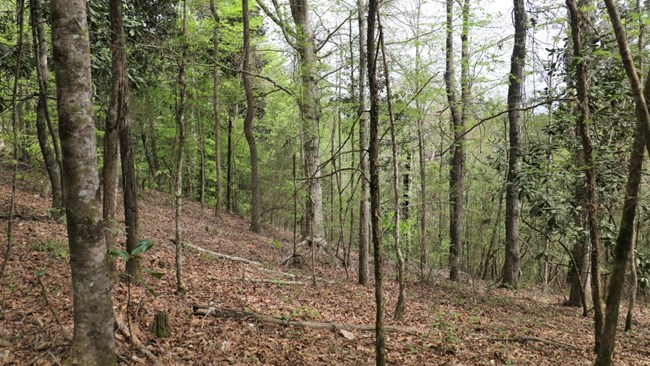
NPS Photo Beech-Magnolia-LoblollyChanges in soil moisture on slopes give rise to distinct vegetation communities that gradate down the slope. The upper slope plant community of longleaf pine and southern red oak gives way to loblolly and shortleaf pines and white oak at mid-slope. This in turn changes to a beech-magnolia-loblolly forest along the lower slope where wetter soil conditions prevail. Dominant shrubs also change with their location on the slopes, going from yaupon, flowering dogwood, and beautyberry to midslope and lower slope shrubs of American holly, American hornbeam, and horse sugar. Sweetgum and blackgum trees may also be present in the wetter, lower slopes. Because of the rarity of these forest types, the Texas Natural Heritage Program considers them imperiled. There is also new evidence that beech-magnolia-loblolly forests are declining, perhaps because of increasing summer temperatures that could be related to global climate change. The Kirby Nature Trail is the best place to explore the beech-magnolia-loblolly plant community. Floodplain Plant Communities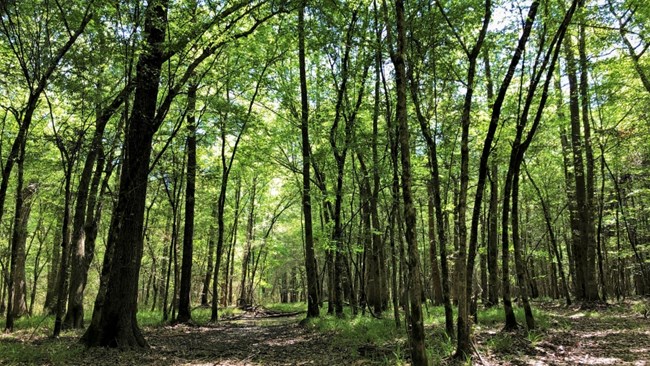
NPS Photo / Scott Sharaga Bottomland FloodplainBottomland floodplains feature trees such as loblolly pine, American beech, American hornbean, sweetgum and water oak. Plants that can tolerate both dry spells and episodes of flooding prefer this environment. When streams flood, water may stand on the land surface for a time rather than draining. This plant community is found in the areas flooded each year by the rivers and larger streams of the Big Thicket. 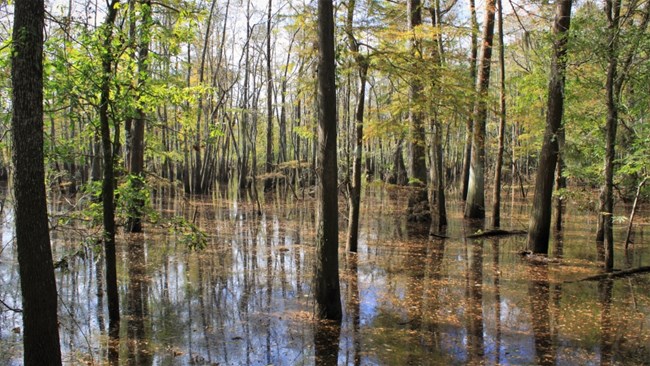
NPS Photo BaygallBaygalls are shrub thickets found along the broad floodplain of the Neches River. Baygalls can also be found in wetland pine savannahs and areas containing springs, seeps, and ponds. The term “baygall” is derived from the occurrence of sweetbay magnolia and gallberry holly, two dominant plants in these communities. A baygall forms when water collects in the bottom of a poorly drained depression. Debris from surrounding vegetation steeps into the water, causing the water to lose oxygen and become more acidic. Tannin from rotting plants colors the water like coffee or root beer. The Kirby Nature Trail provides views of baygalls, as does the Jack Gore Baygall area. 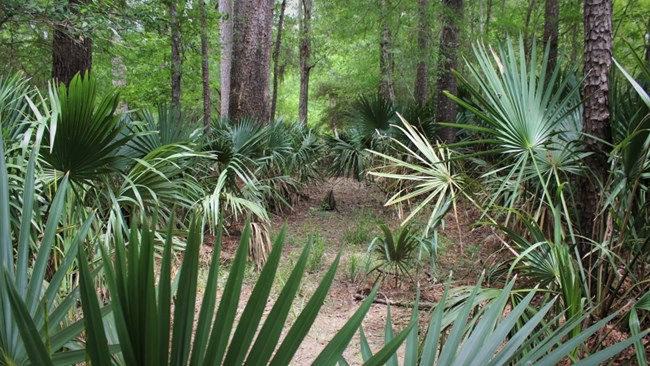
NPS Photo / Scott Sharaga Palmetto Hardwood FlatPalmetto hardwood flats occur in flat, poorly drained areas where water forms ponds for significant periods of time. Dense thickets of dwarf palmetto give this area a jungle-like appearance. Dominant tree species include overcup oak, willow oak, and laurel oak. Abundant sandy mounds also characterize this plant community type and represent small, drier “islands” that often support loblolly pine. The Lance Rosier Unit is the best place to explore this plant community. 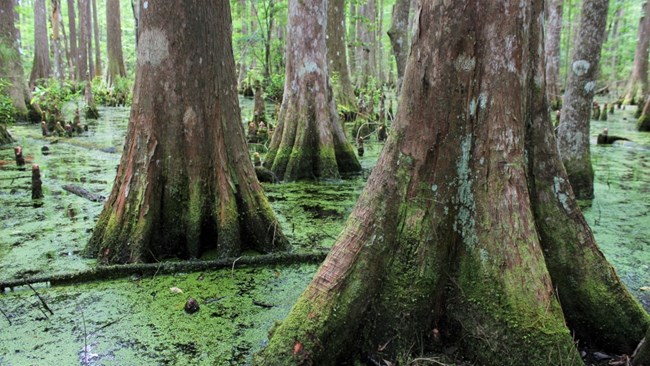
NPS Photo / Scott Sharaga Cypress SloughBald cypress and water tupelo are the dominant tree species of the cypress sloughs found in secondary river and creek channels and along the edges of oxbow lakes and sloughs throughout the preserve. Cypress trees have fluted trunks and knees—woody protrusions growing up from the roots—to help anchor them in wet soil. These primordial forested swamps were once found throughout the Big Thicket region, but now are extremely rare because of extensive cypress logging and river channelization during the last century. While you can see some cypress sloughs along the Kirby Nature Trail and Turkey Creek Trail, the best place to explore them is along the Cooks Lake to Scatterman Lake Paddling Trail. |
Last updated: June 1, 2025
